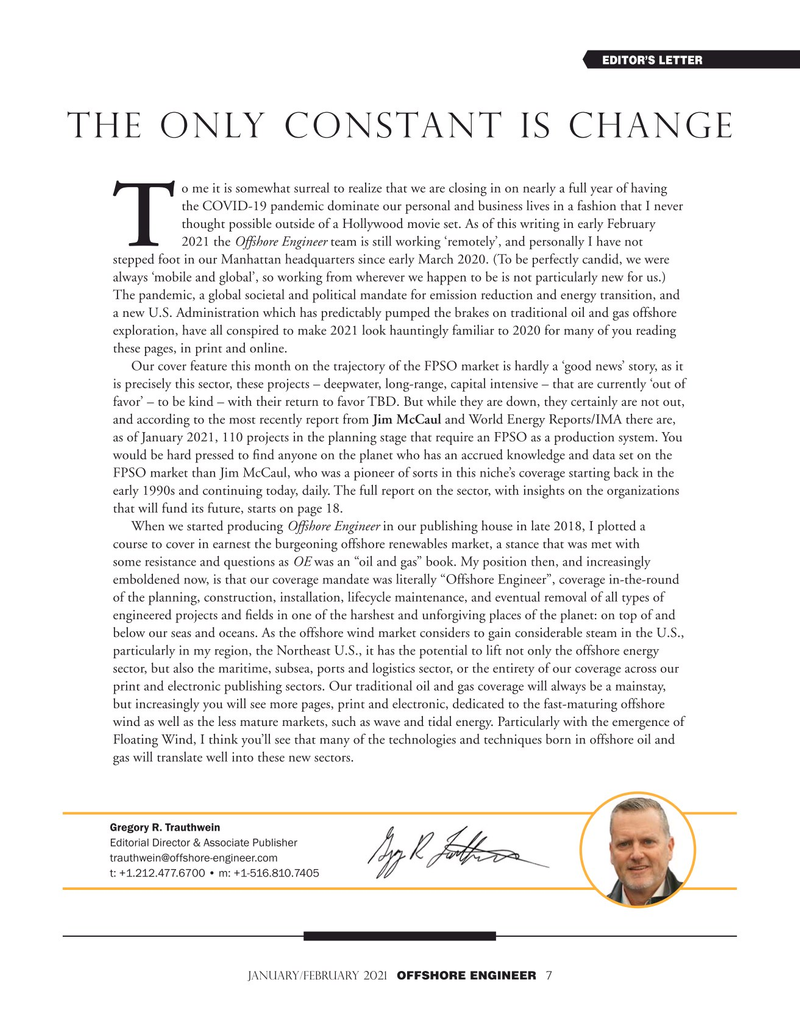
Page 7: of Offshore Engineer Magazine (Jan/Feb 2021)
Floating Production Outlook
Read this page in Pdf, Flash or Html5 edition of Jan/Feb 2021 Offshore Engineer Magazine
EDITOR’S LETTER the only constant is Change o me it is somewhat surreal to realize that we are closing in on nearly a full year of having the COVID-19 pandemic dominate our personal and business lives in a fashion that I never thought possible outside of a Hollywood movie set. As of this writing in early February 2021 the Offshore Engineer team is still working ‘remotely’, and personally I have not
T stepped foot in our Manhattan headquarters since early March 2020. (To be perfectly candid, we were always ‘mobile and global’, so working from wherever we happen to be is not particularly new for us.)
The pandemic, a global societal and political mandate for emission reduction and energy transition, and a new U.S. Administration which has predictably pumped the brakes on traditional oil and gas offshore exploration, have all conspired to make 2021 look hauntingly familiar to 2020 for many of you reading these pages, in print and online.
Our cover feature this month on the trajectory of the FPSO market is hardly a ‘good news’ story, as it is precisely this sector, these projects – deepwater, long-range, capital intensive – that are currently ‘out of favor’ – to be kind – with their return to favor TBD. But while they are down, they certainly are not out, and according to the most recently report from Jim McCaul and World Energy Reports/IMA there are, as of January 2021, 110 projects in the planning stage that require an FPSO as a production system. You would be hard pressed to ?nd anyone on the planet who has an accrued knowledge and data set on the
FPSO market than Jim McCaul, who was a pioneer of sorts in this niche’s coverage starting back in the early 1990s and continuing today, daily. The full report on the sector, with insights on the organizations that will fund its future, starts on page 18.
When we started producing Offshore Engineer in our publishing house in late 2018, I plotted a course to cover in earnest the burgeoning offshore renewables market, a stance that was met with some resistance and questions as OE was an “oil and gas” book. My position then, and increasingly emboldened now, is that our coverage mandate was literally “Offshore Engineer”, coverage in-the-round of the planning, construction, installation, lifecycle maintenance, and eventual removal of all types of engineered projects and ?elds in one of the harshest and unforgiving places of the planet: on top of and below our seas and oceans. As the offshore wind market considers to gain considerable steam in the U.S., particularly in my region, the Northeast U.S., it has the potential to lift not only the offshore energy sector, but also the maritime, subsea, ports and logistics sector, or the entirety of our coverage across our print and electronic publishing sectors. Our traditional oil and gas coverage will always be a mainstay, but increasingly you will see more pages, print and electronic, dedicated to the fast-maturing offshore wind as well as the less mature markets, such as wave and tidal energy. Particularly with the emergence of
Floating Wind, I think you’ll see that many of the technologies and techniques born in offshore oil and gas will translate well into these new sectors.
Gregory R. Trauthwein
Editorial Director & Associate Publisher [email protected] Z[\"\"]^^_^##`Z[\qx\_$\#^]#x january/february 2021 OFFSHORE ENGINEER 7

 6
6

 8
8